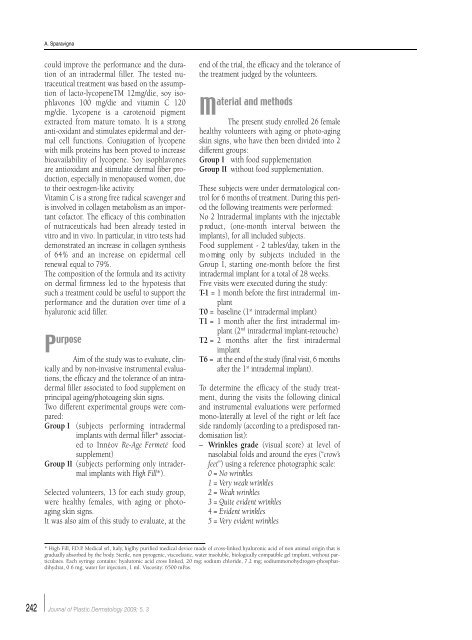Vol. 5, n. 3, September-December 2009 - Salute per tutti
Vol. 5, n. 3, September-December 2009 - Salute per tutti
Vol. 5, n. 3, September-December 2009 - Salute per tutti
Create successful ePaper yourself
Turn your PDF publications into a flip-book with our unique Google optimized e-Paper software.
A. Sparavigna<br />
could improve the <strong>per</strong>formance and the duration<br />
of an intradermal filler. The tested nutraceutical<br />
treatment was based on the assumption<br />
of lacto-lycopeneTM 12mg/die, soy isophlavones<br />
100 mg/die and vitamin C 120<br />
mg/die. Lycopene is a carotenoid pigment<br />
extracted from mature tomato. It is a strong<br />
anti-oxidant and stimulates epidermal and dermal<br />
cell functions. Coniugation of lycopene<br />
with milk proteins has been proved to increase<br />
bioavailability of lycopene. Soy isophlavones<br />
are antioxidant and stimulate dermal fiber production,<br />
especially in menopaused women, due<br />
to their oestrogen-like activity.<br />
Vitamin C is a strong free radical scavenger and<br />
is involved in collagen metabolism as an important<br />
cofactor. The efficacy of this combination<br />
of nutraceuticals had been already tested in<br />
vitro and in vivo. In particular, in vitro tests had<br />
demonstrated an increase in collagen synthesis<br />
of 64% and an increase on epidermal cell<br />
renewal equal to 79%.<br />
The composition of the formula and its activity<br />
on dermal firmness led to the hypotesis that<br />
such a treatment could be useful to support the<br />
<strong>per</strong>formance and the duration over time of a<br />
hyaluronic acid filler.<br />
P urpose<br />
Aim of the study was to evaluate, clinically<br />
and by non-invasive instrumental evaluations,<br />
the efficacy and the tolerance of an intradermal<br />
filler associated to food supplement on<br />
principal ageing/photoageing skin signs.<br />
Two different ex<strong>per</strong>imental groups were compared:<br />
Group I<br />
(subjects <strong>per</strong>forming intradermal<br />
implants with dermal filler* associated<br />
to Innéov Re-Age Fermeté food<br />
supplement)<br />
Group II (subjects <strong>per</strong>forming only intradermal<br />
implants with High Fill*).<br />
Selected volunteers, 13 for each study group,<br />
were healthy females, with aging or photoaging<br />
skin signs.<br />
It was also aim of this study to evaluate, at the<br />
end of the trial, the efficacy and the tolerance of<br />
the treatment judged by the volunteers.<br />
aterial and methods<br />
M<br />
The present study enrolled 26 female<br />
healthy volunteers with aging or photo-aging<br />
skin signs, who have then been divided into 2<br />
different groups:<br />
Group I with food supplementation<br />
Group II without food supplementation.<br />
These subjects were under dermatological control<br />
for 6 months of treatment. During this <strong>per</strong>iod<br />
the following treatments were <strong>per</strong>formed:<br />
No 2 Intradermal implants with the injectable<br />
p roduct, (one-month interval between the<br />
implants), for all included subjects.<br />
Food supplement - 2 tables/day, taken in the<br />
m o rning only by subjects included in the<br />
Group I, starting one-month before the first<br />
intradermal implant for a total of 28 weeks.<br />
Five visits were executed during the study:<br />
T-1 = 1 month before the first intradermal implant<br />
T0 = baseline (1 st intradermal implant)<br />
T1 = 1 month after the first intradermal implant<br />
(2 nd intradermal implant-retouche)<br />
T2 = 2 months after the first intradermal<br />
implant<br />
T 6 = at the end of the study (final visit, 6 months<br />
after the 1 s t intradermal implant).<br />
To determine the efficacy of the study treatment,<br />
during the visits the following clinical<br />
and instrumental evaluations were <strong>per</strong>formed<br />
mono-laterally at level of the right or left face<br />
side randomly (according to a predisposed randomisation<br />
list):<br />
– Wrinkles grade (visual score) at level of<br />
nasolabial folds and around the eyes (“crow’s<br />
feet”) using a reference photographic scale:<br />
0 = No wrinkles<br />
1 = Very weak wrinkles<br />
2 = Weak wrinkles<br />
3 = Quite evident wrinkles<br />
4 = Evident wrinkles<br />
5 = Very evident wrinkles<br />
* High Fill, F.D.P. Medical srl, Italy, higlhy purified medical device made of cross-linked hyaluronic acid of non animal origin that is<br />
gradually absorbed by the body. Sterile, non pyrogenic, viscoelastic, water insoluble, biologically compatible gel implant, without particulates.<br />
Each syringe contains: hyaluronic acid cross linked, 20 mg; sodium chloride, 7.2 mg; sodiummonohydrogen-phosphatdihydrat,<br />
0.6 mg; water for injection, 1 ml. Viscosity: 6500 mPas.<br />
242<br />
Journal of Plastic Dermatology <strong>2009</strong>; 5, 3

















